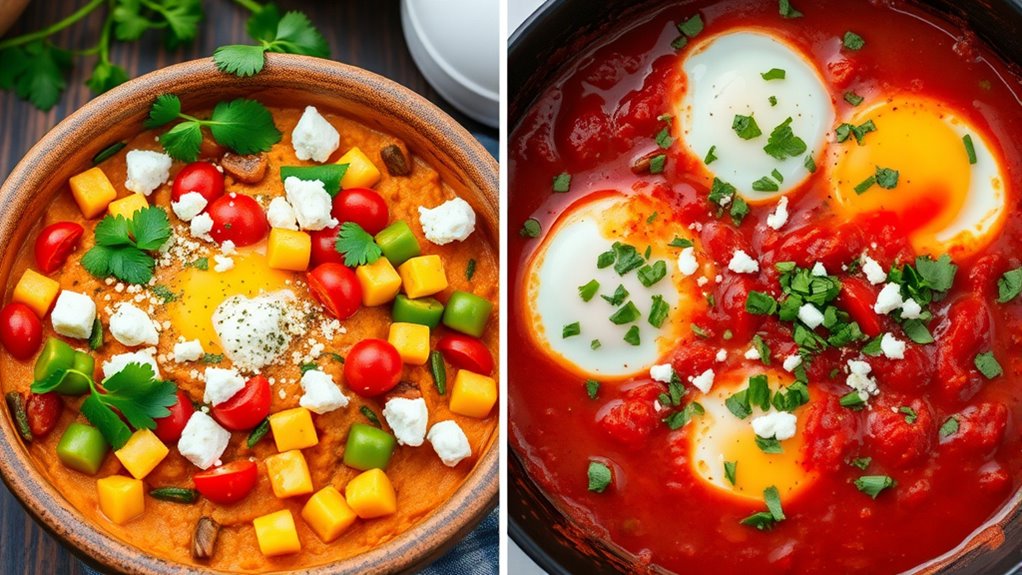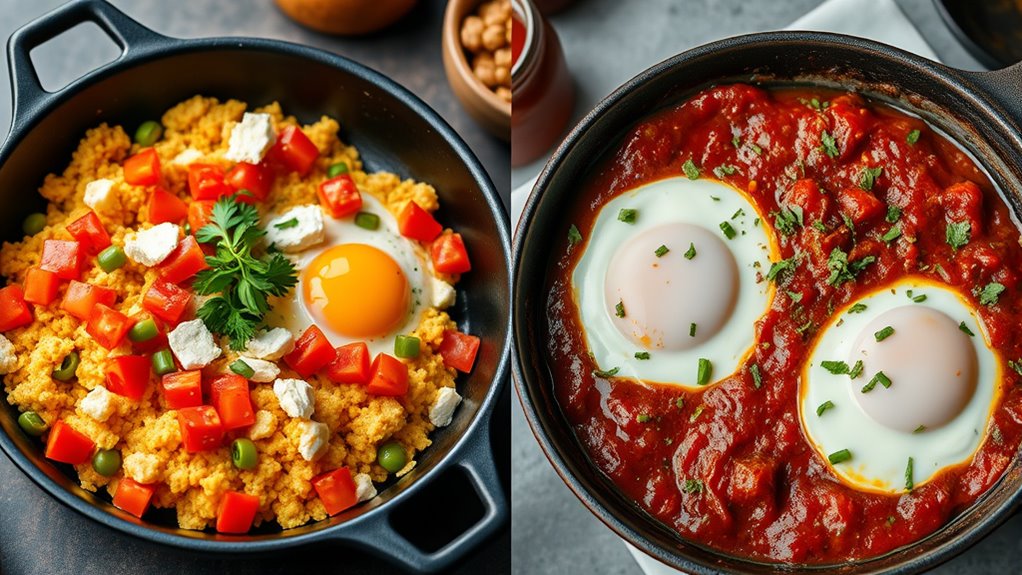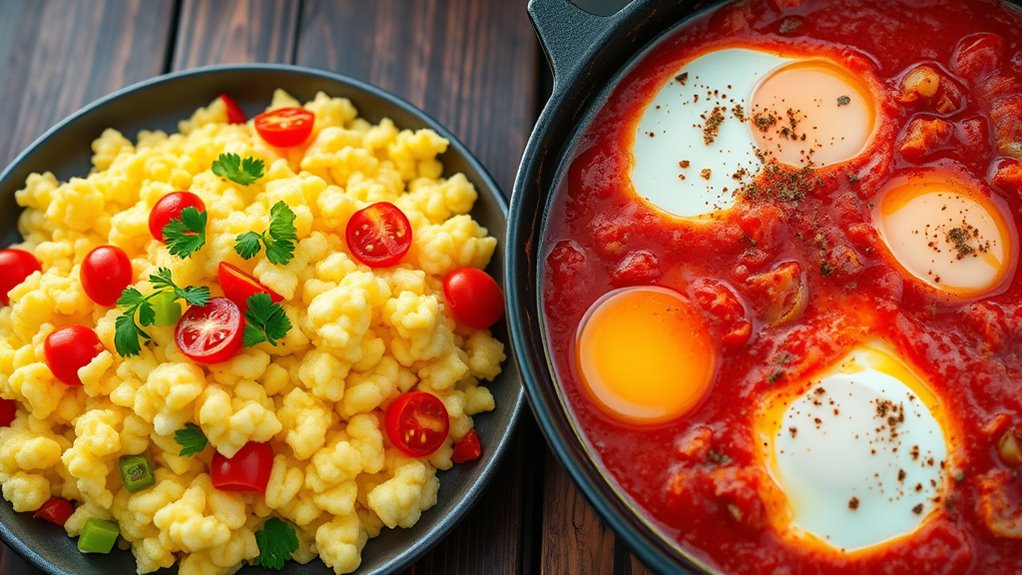Turkish Menemen and Shakshuka are both tomato and egg dishes, but they differ in flavor and style. Menemen, typical for breakfast, features fresh tomatoes, peppers, and onions cooked with eggs in a savory, mildly seasoned way, often served with bread. Shakshuka has a richer, spiced tomato sauce with cumin and chili, usually cooked with eggs tucked in the sauce. Discover more nuances that make each dish unique and culturally rich by exploring further.
Key Takeaways
- Menemen is a Turkish breakfast dish with eggs cooked directly into sautéed tomatoes, peppers, and onions, served with bread.
- Shakshuka is a North African/Middle Eastern dish with eggs poached in a spiced tomato sauce, often flavored with cumin and chili.
- Menemen has a softer, scrambled egg texture with milder seasonings; Shakshuka features a richer, bolder flavor profile.
- Menemen is typically served in the pan or a shallow plate, while Shakshuka is served directly in its cooking skillet for sharing.
- Both dishes are served with bread, but Menemen emphasizes fresh vegetables and Turkish herbs, whereas Shakshuka highlights bold spices and regional influences.
Origins and Cultural Significance

Turkish menemen and Middle Eastern shakshuka both have rich histories rooted in their respective cultures, but menemen’s origins are especially tied to Turkey’s culinary identity. Menemen likely developed in the early 20th century, blending traditional Turkish flavors with Ottoman influences. It’s considered a staple breakfast dish and a symbol of Turkish hospitality and daily life. Throughout history, menemen has been served across social classes, from village homes to urban cafes, reflecting its importance in Turkish culture. Its simple yet hearty nature embodies Turkish values of sharing and community. Over time, menemen has become more than just a meal; it’s a cultural icon representing Turkey’s culinary heritage and the warmth of its hospitality. The preparation and traditional cooking methods of menemen have been passed down through generations, preserving its authentic character.
Core Ingredients and Preparation Techniques

At its core, menemen relies on fresh, simple ingredients that come together quickly to create a hearty breakfast. You’ll need ripe tomatoes, green peppers, and onions, chopped finely. Eggs are added last, often directly into the sautéed vegetables, and gently stirred to create a soft, scrambled consistency. Olive oil is essential for sautéing, and some recipes include a pinch of salt and pepper. The preparation technique involves cooking the vegetables until tender, then adding eggs to cook just enough to set but remain creamy. The key is to keep the heat moderate, ensuring the eggs don’t overcook. Menemen is traditionally cooked in a shallow pan, making it easy to stir and serve directly from the stove. This simple process highlights the freshness and quality of the ingredients. Using the proper cooking techniques ensures the eggs are perfectly creamy and the vegetables retain their flavor.
Flavor Profiles and Seasonings

The flavor profiles of menemen and shakshuka are both vibrant and comforting, but they achieve their distinct tastes through different seasonings. Menemen typically features fresh, bright flavors from ingredients like green peppers, tomatoes, and onions, seasoned with mild spices like black pepper and sometimes paprika. It often includes a splash of olive oil and fresh herbs such as parsley or dill, enhancing its freshness. Shakshuka, on the other hand, boasts a richer, bolder profile with spices like cumin, paprika, and chili powder that give it warmth and depth. Garlic and onion are foundational, providing savory undertones. The smoky, spicy notes in shakshuka set it apart from the milder, herbaceous flavor of menemen. Both dishes rely on seasoning to define their character, yet each offers a unique taste experience.
Serving Styles and Traditional Accompaniments

Menemen and shakshuka each have distinctive serving styles that highlight their cultural roots and traditional practices. With menemen, you typically serve it directly in the pan or transfer it to a shallow plate, often accompanied by fresh bread like Turkish pide or crusty loaves. It’s common to enjoy it as a breakfast dish, with the bread used to scoop up the eggs and vegetables. Shakshuka, on the other hand, is usually served in the skillet it’s cooked in, making it easy to share. You often add a side of warm flatbread or pita to scoop up the flavorful tomato sauce and eggs. Sometimes, garnishes like fresh herbs, feta, or hot sauce are added, but the core idea remains to serve it family-style or communally, highlighting its Middle Eastern roots.
Variations and Modern Twists

Both menemen and shakshuka have inspired a range of modern twists that reflect contemporary tastes and culinary creativity. Chefs now experiment with ingredients like feta, avocado, or spicy chorizo to elevate the dishes. You might find versions served with gluten-free bread or topped with fresh herbs and microgreens for added flavor and visual appeal. These variations cater to diverse diets and preferences, blending tradition with innovation. Additionally, culinary innovation has led to creative presentations and flavor combinations that appeal to modern palates. Incorporating cultural influences from different cuisines has enriched these dishes, making them more versatile and globally appealing. Some chefs also explore nutritional enhancements by adding ingredients like chia seeds or superfoods to boost health benefits. Exploring regional adaptations allows chefs to honor local flavors while maintaining the essence of the dish. Here’s a quick look at different twists: Essential survival gear can enhance your outdoor cooking experiences and ensure safety when trying new recipes in remote settings.
Frequently Asked Questions
Which Dish Is Spicier, Menemen or Shakshuka?
You might wonder which dish is spicier, menemen or shakshuka. Generally, shakshuka tends to be spicier because it often includes chili peppers and spices like cayenne or harissa. Menemen, on the other hand, usually has milder flavors, focusing on tomatoes and peppers with less heat. Your spice preference will guide your choice, but shakshuka usually packs a bit more of a fiery punch.
Can These Dishes Be Made Vegan?
Imagine you’re crafting a masterpiece; you can customize it to your taste. Both menemen and shakshuka can be made vegan easily. Swap out eggs for tofu or chickpeas, and replace cheese with plant-based options. I once made a vegan shakshuka, and the flavors still burst like fireworks. So, yes, with a few thoughtful tweaks, you can enjoy these dishes without any animal products.
How Long Does Each Dish Typically Take to Prepare?
You’ll find that both dishes usually take around 20 to 30 minutes to prepare. Menemen often comes together quickly because it involves sautéing vegetables and eggs, which cook fast. Shakshuka might take a bit longer, as you simmer tomatoes and spices first. Overall, with some prep, you can have either dish ready in half an hour, making them perfect for a flavorful, quick meal.
Are There Regional Differences Within Turkey or North Africa?
You’ll find regional differences within Turkey and North Africa that influence how these dishes are prepared. In Turkey, Menemen varies from coastal areas to inland regions, with some adding spices or cheese. In North Africa, Shakshuka recipes differ across countries; for example, Tunisian versions include harissa for added spice, while Moroccan styles might incorporate preserved lemons. These variations reflect local ingredients and culinary traditions, giving each dish a unique regional touch.
Which Dish Pairs Better With Bread or Other Sides?
Ever wondered which dish complements bread or sides better? Both Menemen and Shakshuka pair wonderfully with fresh, crusty bread to scoop up the flavorful sauces and eggs. Menemen’s softer, milder texture makes it perfect for a quick breakfast, while Shakshuka’s spicier, tomato-rich base offers a hearty, satisfying bite. Ultimately, it depends on your taste—are you craving a gentle start or a bold, spicy experience?
Conclusion
Whether you prefer the savory simplicity of Turkish menemen or the spicy richness of shakshuka, both dishes offer unique cultural flavors. For instance, imagine hosting friends and serving menemen with fresh bread—it’s a comforting, versatile dish that brings people together. Exploring these variations not only broadens your culinary horizons but also deepens your appreciation for Middle Eastern and Mediterranean traditions. So, next time you cook, embrace the differences and enjoy the delicious journey!









